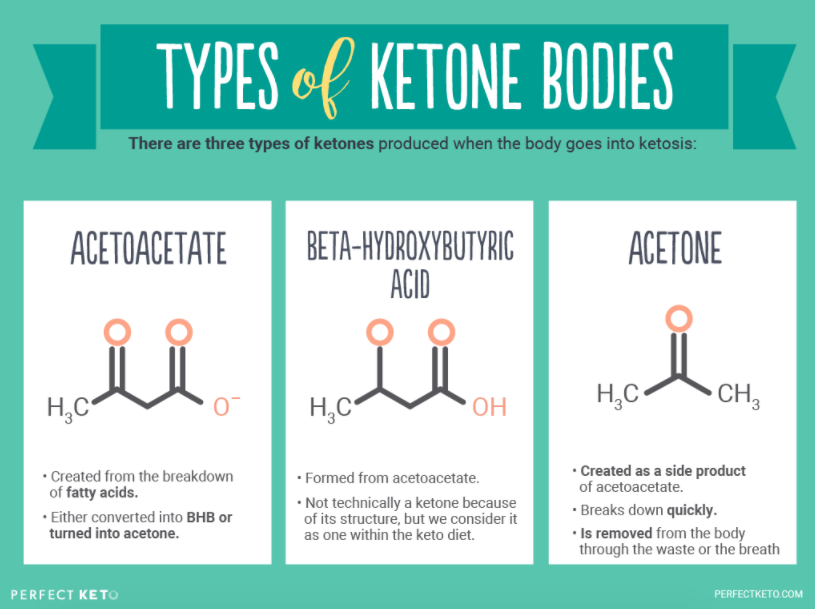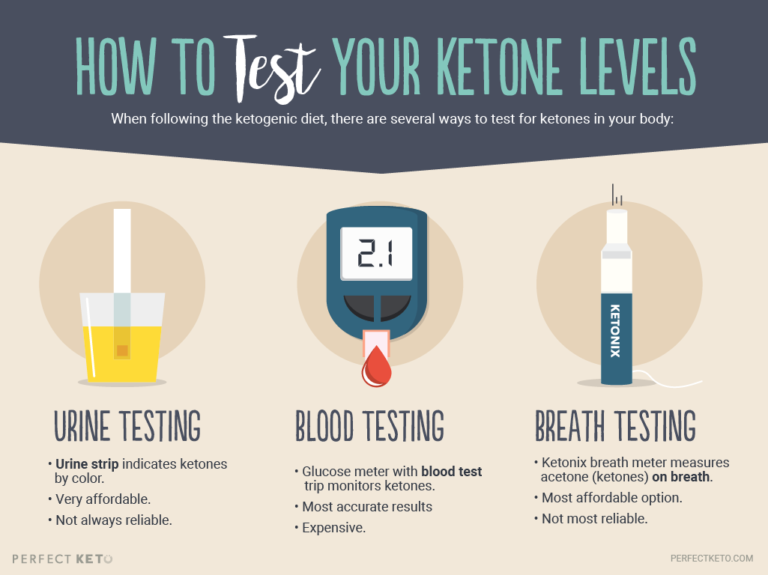What is acetone? That question can be a bit tricky to answer. It can be produced naturally in the human body or chemically in factories.
Acetone is the smallest ketone body, found naturally (and safely) in the human body. It’s produced during the ketosis process, which has many health benefits.
However, because this compound can be synthetically produced in labs, you’ll see it listed as an active ingredients in household products, nail polish remover, and even glassware cleaner. Therefore, there is widespread confusion over this substance and its safety.
What Is Acetone?
Acetone is an organic compound. It has the chemical formula C3H6 and also goes by the chemical names dimethyl ketone, propanone, and 2-propanone[*]. It is found naturally in the environment, but is also used in labs to create industrial products.
Industrial Acetone
Acetone is a flammable liquid, typically used in everything from paint thinner and plastics to detergents and rubber cement[*]. In the United States, the FDA has even approved it as a food additive for adhesives[*].
Acetone is an organic solvent — it dissolves other liquids (you may have seen it advertised as a “green solvent,” or a more natural cleaner), and is usually made with isopropyl alcohol[*].
You can use it to clean glassware or as a nail polish remover, swabbing last week’s manicure right off your nails. And while this colorless liquid might look harmless at your salon, acetone is quite heavy duty. It can strip the paint right from your walls, and can cut through varnishes, waxes, lacquer, and glues.
Exposure to this chemical, either by air or by coming into contact with your skin or eyes can cause adverse health effects. High concentrations can cause acetone poisoning, meaning your body is taking in more acetone than your liver can break down[*].

How Is Acetone Found in the Human Body?
While all this paints a picture of acetone as a harmful chemical, remember: Acetone is produced naturally in the environment. Acetone occurs in trees, forest fires, volcanic gases, and the body when fat stores are broken down[*].
Acetone is a natural metabolic product of both plants and animals — and yes, that includes humans[*]. Everybody has small amounts of acetone in their bodies.
Acetone Is a Type of Ketone
When you’re following a ketogenic diet, you’ll produce large amounts of acetone compared to those eating a high-carb diet.
When someone eats a high-fat and low-carb diet or is engaged in prolonged fasting, there isn’t enough glucose in the body for fuel. Therefore, the liver starts breaking down fatty acids for energy to fuel the body and the brain. This is the process known as ketosis, the primary function and goal of the ketogenic diet.
How Acetone Enters Your Bloodstream
When ketosis happens, water-soluble molecules called ketone bodies, or just simply “ketones,” are released. These three ketones are:
- Acetoacetate
- Betahydroxybutyrate
- Acetone
Acetoacetate is created first, followed by beta-hydroxybutyrate and acetone. Acetone is created spontaneously from the breakdown of acetoacetate and is the simplest and most volatile ketone. It diffuses into the lungs and exits the body when you exhale.
Acetone Safety in the Human Body
Because acetone is found naturally (within the human body) and synthetically (in the production of industrial and personal care products), there is quite a bit of confusion surrounding its safety.
Remember: You have acetone in your body due to the breakdown of body fat. This compound is just one byproduct of reaching ketosis, and its presence can be helpful for monitoring progress and improving the health of those who follow the keto diet.
Ketones produced while eating a low-carb, high-fat diet (like the ketogenic diet) puts the body in nutritional ketosis. This is not the same as the harmful state of diabetic ketoacidosis (DKA), which can occur in people with unmonitored or uncontrolled type 1 diabetes[*]. For a full explanation, see the post, Is Ketosis Dangerous?
Ketosis is a safe metabolic state for those on a healthy, whole-food keto diet and should not be confused with DKA. If you have any confusion or concerns about what state you’re in, contact your doctor right away.
Acetone Safety When Found In the Environment
What is acetone? Well, if it isn’t produced by your own body, it’s considered a toxic substance. The National Institute for Occupational Safety and Health classifies acetone as a volatile organic compound. Therefore, it’s important to practice chemical safety when dealing with it.
Cancer Risk
The Environmental Protection Agency’s Integrated Risk Information System program (IRIS) is dedicated to identifying any health hazards coming from chemicals found within the environment. So far, the EPA has not shown acetone to cause cancer. In one test, acetone was shown to not cause skin cancer in animals[*].
Exposure Symptoms
Health effects of pure acetone are mild. If you do come into contact with it, your symptoms will vary depending upon your exposure level. Small amounts will only irritate the skin and eyes, while repeated exposure could cause dermatitis[*].
Prevention measures include wearing protective gloves and clothing and keeping the space ventilated. If acetone comes into contact with your skin or eyes, first aid measures include removing any contaminated clothing and flushing the area with water[*].
Exposure to Industrial Workers
What makes acetone dangerous is that it is so highly flammable. It has a flash point of −20 °C (−4 °F) and a boiling point of 56.05 °C (132.89 °F). It’s important to keep it away from open flames or other ignition sources during production, as it can cause a fire at anything above its flash point[*]. Because it’s a liquid, it can produce vapor that travels to a distant ignition source.
To protect workers who work with acetone, the Occupational Safety and Health Administration (OSHA) of both the United States and Canada set “threshold limit values” for the substance. Essentially, this is an “exposure limit” to how much a worker can come into contact with it over his or her lifetime without adverse health effects.
Acetone Benefits on the Keto Diet
One way that keto dieters can ensure they maintain ketosis, and receive the benefits of ketosis, is by measuring the amount of acetone on the breath. Typically, the higher amount of acetone present, the further you are into ketosis.
Weight Loss Benefits
There are many reasons someone might choose to follow a keto diet and put their body in ketosis. Benefits of being in ketosis include (but aren’t limited to)[*]:
- Significant and hunger-free weight loss
- More fat burn, since the body turns to fat stores instead of carbs for energy
- Stabilized blood sugar from little to no carb intake and slow fat burn
- Improved cholesterol and triglyceride levels
- Less chance of inflammation in the body, which has been linked to acne and other conditions
- Regulation of hormones
Research has also shown a strong correlation between the rate of fat loss and breath acetone concentration (amount of acetone on the breath).
Neurological Benefits
One well-known connection in the medical community between a ketogenic diet and health benefits is the ability to calm neurological conditions like epilepsy.
- In a 2003 study with rats, researchers found acetone suppressed seizures in four types of experimental animal models
- Besides the benefits of a keto diet itself, current data also shows ketone bodies, including acetone, could represent their own distinctive therapeutic qualities in those with epilepsy and maybe other neurological disorders
With these benefits in mind, the importance of monitoring ketone levels while following a keto diet makes sense. Thankfully, monitoring is fairly easy.
How to Test for Acetone
There are a few different ways to measure ketones in the body, but acetone is most commonly monitored on the breath.

When ketones are created during fat metabolism, they are released from the body in different ways, meaning they can be measured in three different areas of the body.
As mentioned above, acetone is most detectable on the breath, and often produces what many describe as a fruity, if not nail polish-like smell. This is called keto breath.
One can test for the presence of acetone on the breath using a ketone breath monitor, like the Ketonix meter, which measures how much of the ketone is exhaled in the breath. Typically, a breath monitor reading of between 40 and 80 indicates nutritional ketosis.
It might seem pricey to buy a breath meter, but the benefit is that you can use it forever. By comparison, the repeat purchase required for urine or blood testing strips may make breath testing a more cost-effective method.
The downside to measuring ketone levels through acetone on the breath is that it’s not always the most reliable method for testing. As such, you might want to sometimes combine it with other testing methods. Still, it’s an easy, non-invasive way to monitor your ketone levels, especially when first starting on a keto diet.
Acetone Is Found Naturally in the Body and Synthetically in Factories
So what is acetone, exactly? It’s one confusing compound, that’s for sure. On the one hand, it’s found naturally in the human body. On the other, it’s produced in factories and used in industrial products such as paint thinner, glass cleaner, and nail polish remover.
While acetone is an important solvent present in many household products, that’s not the kind of acetone involved with ketosis. Acetone is one of three ketones found in your body. It’s not harmful to your health — in fact, every human being has some acetone present in their bodies.
To learn about the other two ketone bodies, read up on acetoacetate and betahydroxybutyrate. Also, beta hydroxybutyrate is the ketone that will give you the most success when trying to enter ketosis, and can be found in Perfect Keto’s Exogenous Ketone Base. Use it to boost your ketone levels, enter ketosis initially, or get back into ketosis after one too many grams of carbs.